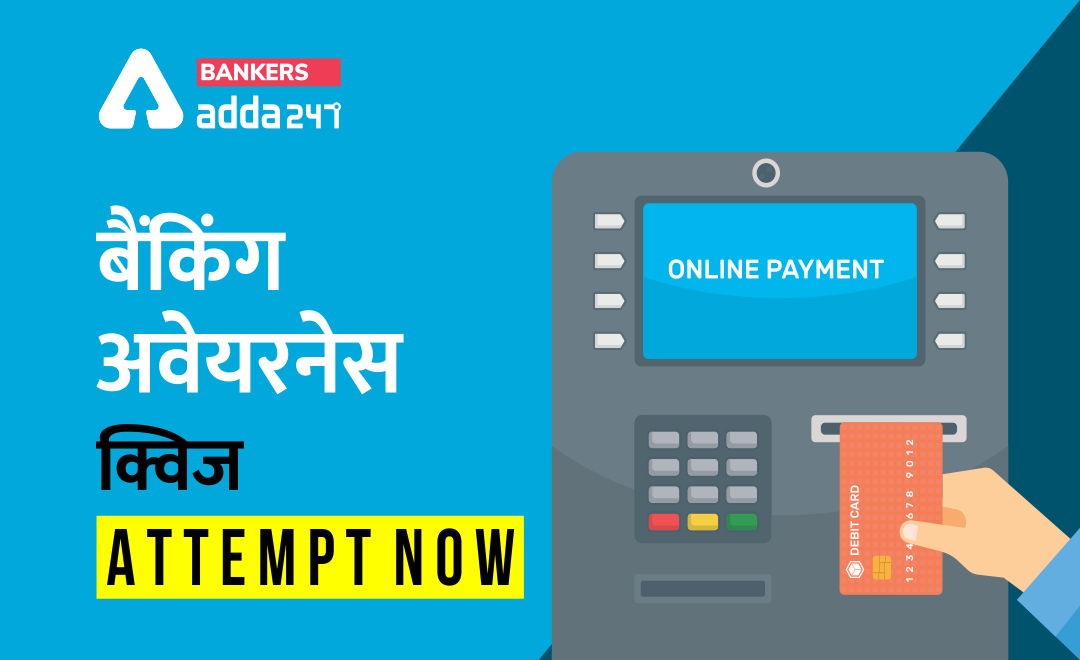
Risk in Banking
Q1. जब अपर्याप्त या विफल आंतरिक प्रक्रियाओं, लोगों और प्रणालियों या बाहरी घटना से होने वाले नुकसान का जोखिम होता है, तो इसे कहा जाता है-
(a) तरलता जोखिम
(b) परिचालन जोखिम
(c) प्रणालीगत जोखिम
(d) मोरल हजार्ड
(e) इनमें से कोई नहीं
Q2. निम्नलिखित में से कौन बाज़ार जोखिम का प्रमुख घटक नहीं है?
(a) इक्विटी जोखिम
(b) विदेशी मुद्रा जोखिम
(c) ब्याज दर जोखिम
(d) क्रेडिट जोखिम
(e) इनमें से कोई नहीं
Q3. जब एक बैंक उधारकर्ता, या पार्टी का पक्ष, बैंक के साथ सहमत शर्तों के बारे में अपने भुगतान दायित्वों को पूरा करने में विफल रहता है, तो इसे कहा जाता है-
(a) क्रेडिट जोखिम
(b) परिचालन जोखिम
(c) बाजार जोखिम
(d) तरलता जोखिम
(e) इनमें से कोई नहीं
Q4. जब बैंक अपने दैनिक कार्यों को करने के लिए पर्याप्त नकदी नहीं रख पाता है, तो इसे कहा जाता है-
(a) प्रणालीगत जोखिम
(b) तरलता जोखिम
(c) बाजार जोखिम
(d) परिचालन संबंधी जोखिम
(e) इनमें से कोई नहीं
Q5. जब कोई बैंक गलत रणनीति चुनता है या दीर्घकालिक व्यापार रणनीति का अनुसरण करता है जिससे उसकी विफलता हो सकती है, तो इसे कहा जाता है-
(a) व्यापार जोखिम
(b) बाजार जोखिम
(c) परिचालन संबंधी जोखिम
(d) क्रेडिट जोखिम
(e) इनमें से कोई नहीं
Q6. जब कार्रवाई पूरी वित्तीय व्यवस्था को गतिरोध में ले जा सकती है, तो इसे कहा जाता है-
(a) बाजार जोखिम
(b) व्यवस्थित जोखिम
(c) व्यावसायिक जोखिम
(d) इक्विटी जोखिम
(e) इनमें से कोई नहीं
Q7. जब बैंक के खिलाफ या कानूनी रूप से गलत तरीके से कानून लागू करने के लिए दायर कानूनी मुकदमों से बैंक को वित्तीय नुकसान होता है, तो इसे कहा जाता है-
(a) बाजार जोखिम
(b) व्यवस्थित जोखिम
(c) इक्विटी जोखिम
(d) कानूनी जोखिम
(e) इनमें से कोई नहीं
Q8. जब एक बैंक यह निर्णय लेता है कि कितना जोखिम लेना है, जबकि चीजें ख़राब होने पर लागत कोई और (जैसे सरकार) वहन करती है, तो इसे कहा जाता है-
(a) बाजार जोखिम
(b) इक्विटी जोखिम
(c) मोरल हजार्ड
(d) व्यवस्थित जोखिम
(e) इनमें से कोई नहीं
Q9. जब बैंक की छवि और सार्वजनिक स्थिति संदेह में होती है और किसी बैंक में जनता के विश्वास की हानि होती है, तो इसे कहा जाता है
(a) बाजार जोखिम
(b) प्रतिष्ठित जोखिम
(c) परिचालन संबंधी जोखिम
(d) मोरल हजार्ड
(e) इनमें से कोई नहीं
Q10. जब बाजार की कीमतों में उतार-चढ़ाव की स्थिति में आन्दोलन से नुकसान का जोखिम होता है, तो इसे कहा जाता है-
(a) परिचालन जोखिम
(b) तरलता जोखिम
(c) प्रणालीगत जोखिम
(d) बाजार जोखिम
(e) इनमें से कोई नहीं
SOLUTIONS:
S1. Ans.(b)
Sol. The Basel Committee on Banking Supervision defines operational risk “as the risk of loss resulting from inadequate or failed internal processes, people and systems or from external events. This definition includes legal risk, but excludes strategic and reputation risk.”
S2. Ans.(d)
Sol. The major components of Market risk are: Interest rate risk, Equity risk, Foreign exchange risk, Commodity risk.
S3. Ans.(a)
Sol. When the customers show their inability to pay the loan amounts taken from bank, is called credit risk.
S4. Ans.(b)
Sol. Liquidity means a bank has the ability to meet payment obligations primarily from its depositors and has enough money to give loans. So liquidity risk is the risk of a bank not being able to have enough cash to carry out its day-to-day operations.
S5. Ans.(a)
Sol. When a bank chooses the wrong strategy or follows a long-term business strategy which might lead to its failure, it is called as Business risk.
S6. Ans.(b)
Sol. It can also be stated as the possibility that default or failure by one financial institution can cause domino effects among its counter parties and others, threatening the stability of the financial system as a whole.
S7. Ans.(d)
Legal risk is the risk of financial or reputational loss that can result from lack of awareness or misunderstanding of, ambiguity in, or reckless indifference to, the way law and regulation apply to your business, its relationships, processes, products and services.
S8. Ans.(c)
Sol. Moral hazard is the risk that a party has not entered into a contract in good faith or has provided misleading information about its assets, liabilities, or credit capacity.
S9. Ans.(b)
Sol. Reputational risk is the risk of damage to a bank’s image and public standing that occurs due to some dubious actions taken by the bank.
S10. Ans.(d)
Sol. The market is always fluctuating so there is always market risks in the banking systems. So it can go up and down, and when down banks will charge more interest rates from the customers.


